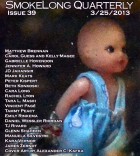It’s not easy to introduce dragons to a reader without invoking the commonality of fairy tales, and yet you make this story feel real and serious. Your excellent use of specific details helps to set this tone. Did you, Kelly and Carol, worry about being taken seriously?
Carol: Kelly gets all the credit for the opening lines; I agree that the details are just perfect. One of the reasons I wanted to collaborate with Kelly is her ability to design believable and unique characters using kinesthetic detail.
“With Dragon” is the title story in a manuscript of short stories we’re writing together. Our process is simple: we each write half a story, then pass it along for the other person to finish. All the stories revolve around a human who becomes pregnant with an animal baby. We knew from the start that we wanted our work to appeal to an adult audience; to be edgy, yet believable; and to avoid the sentimental, sexist rhetoric that sometimes accompanies writing about maternity and parenting. We’re both queer writers, and while we never discussed this, I knew that in collaborating with Kelly we would inevitably craft characters who twist conventions of gender, sex, sexuality, and family. I wasn’t worried about offending her.
We’re invested in using human-animal conflicts to explore what it means to be human. In finishing “With Dragon,” I focused on the idea that good parenting means allowing your child to leave home to find their way in the world. Although our dragon child’s departure may be more dramatic than most, the mother’s emotions and fears are the same as any mother’s.
I should add that another fun element of our collaboration is that Kelly is a parent, while I’ve chosen not to have children. I love that this project allows me to imagine ways my life might be different, and to learn from Kelly about some of the pleasures and perils of parenting.
Kelly: For me, your question has been at the heart of this project since the beginning. I’m a fan of contemporary fables and fairy tales, but the ones I like best have a current of real conflict or emotion running through them, something weighty that I can identify with amid the swirling of magical details. So in writing about women pregnant with things like dragons, I’m aware of trying to be realistic but also always looking for meaning in the details. One thing that is particularly fun about this project is that the subject of pregnancy is so fraught with fairy-tale-like symptoms and advice that it’s not a far leap into the land of fantasy. But for me, the trick is to keep returning to these women (and men) whose emotions I can identify with.
Incidentally, my five-year-old son has been obsessed with dragons for a while now, and so I’ve been reading lots of children’s books on the history and lore of dragons. Like the real old fairy tales, some dragon lore can be frightening, bizarre, and downright gruesome. But the details were what captivated me: dragons that have poison breath, dragons that love milk, baby dragons that start out as tiny worms, dragons that control the weather—to me, these strange details seemed like the perfect companion to (what can be) the bizarre and sometimes gruesome facts of pregnancy and childbirth. It was so much fun to discover what this character might feel, how she would act, and what she would crave when pregnant with the dragon. And I thought the way Carol finished the story, by shifting the focus to the dynamic between mother and child, was perfect.
There are two of you working on this material. I’m curious about what happens after the first draft when half is from Kelly and half from Carol. How do you deal with the revision part of the process?
Carol: I’m not sure how to answer that question because we haven’t gotten there yet! That is, we agreed that we’d do a major revision when the manuscript was finished, but so far our process has been: half Kelly, half Carol (or vice versa). We work carefully, revising our own material and tidying things up to send them out, but the bigger revision process hasn’t happened. When I’m on my own, I revise like crazy; I can spend hours on a line; I just revise as I go and I am also basically always writing, all day, every spare minute. I don’t put things in drawers for six months and take them out later to revise them. It’s an ongoing process.
Kelly: This question was something I wondered about initially, too, especially since I am usually a very heavy reviser—I can go through dozens of drafts for one story. And I do go through a few drafts, usually, of the story parts I send to Carol, but once she finishes it, it’s done. So that’s a really new experience for me. Same thing when she sends me a story beginning—I’ll go through a few drafts of an ending, but then it’s done. The pace of our collaboration is much faster than I usually write, but that has been so energizing for me, and I’m really grateful for the way it’s invigorated my writing.
Since you haven’t finished the collection, you haven’t done a major revision, but you are working carefully as you go. The care you’ve both taken is obvious in this story. Why did you choose “With Dragon” to send out now?
Carol: “With Dragon” is one of our strongest pieces and the title piece to our collection. I suggested sending it to SmokeLong Quarterly because I wanted you to have a shot at our strongest work. I was rejected from the journal not too long ago; when I get a rejection, I try to turn that experience into something positive. Sending you our best work was that positive gesture for me.
I also know that SmokeLong allows writers to work with artists to illustrate their pieces. I had an artist in mind for this piece—my friend Clyde Petersen, who also plays in a band and makes music videos. I thought if SmokeLong took “With Dragon,” I might be able to persuade Clyde to illustrate our story, and I was right! In fact, he’s agreed to illustrate the complete collection when we’re done, so that’s a second positive thing that came out of a rejection.
Finally, I’ve noticed that SmokeLong has a really vibrant aesthetic; stories tend to be highly detailed, as imagistic as prose poems, yet still capture a narrative arc. “With Dragon” is both imagistic and narrative. Some of our other stories fall more on one side of that continuum or another, but this story just seemed like the perfect fit.
Kelly: And I would second what Carol says about Smokelong Quarterly‘s unique aesthetic, and about how wonderful it is to work with an artist (Clyde) for this piece. The story was very vivid to me while writing it, so I’m thrilled to see it published in a journal that allows writers to pair with visual artists.
Is there anything you’ve learned about yourself as a writer from this experience of working so closely with another writer? Has the experience given you insights into your work, something you might not have learned except in this way?
Carol: Collaboration is an ongoing prompt. I want to impress whoever I’m writing with; I feel pressure to write well and quickly. Beyond that, it’s natural to try to match the strengths of my collaborator. Kelly handles long forms so beautifully—she writes gorgeous longer stories, and is working on a fabulous novel—and I’ve gotten away from long forms over the past decade. With some of our stories, my impulse was to consider the story finished after I’d written a paragraph! To make it microfiction, a prose poem, an erasure. But instead I had to keep writing past that poetic moment. I had to make the characters do something; sound alone wasn’t creating narrative tension. Kelly’s quite good at this, so I’m borrowing from her strengths here to teach myself something new.
Kelly: This is the first collaboration I’ve done, and yes, I’ve learned a ton from Carol. She makes these great creative leaps—sometimes in time, sometimes in point of view, sometimes in style—that work so well to move a story along and keep it contained within the short form. I especially love the way several of these stories jump through time, boiling whole scenes down to their most essential image or line. I’ve learned a lot about what to leave out from Carol.
I also think that there’s so much energy and excitement to be gained from working with another writer, and I wouldn’t have gotten that on my own. The pace of this writing has been much faster than I’m used to writing on my own, but I’ve benefited so much from the speed. It’s shown me how much can be accomplished in both a small space and a short time.



 The core workshop of SmokeLong Fitness is all in writing, so you can take part from anywhere at anytime. We are excited about creating a supportive, consistent and structured environment for flash writers to work on their craft in a community. We are thrilled and proud to say that our workshop participants have won, placed, or been listed in every major flash competition. Community works.
The core workshop of SmokeLong Fitness is all in writing, so you can take part from anywhere at anytime. We are excited about creating a supportive, consistent and structured environment for flash writers to work on their craft in a community. We are thrilled and proud to say that our workshop participants have won, placed, or been listed in every major flash competition. Community works.